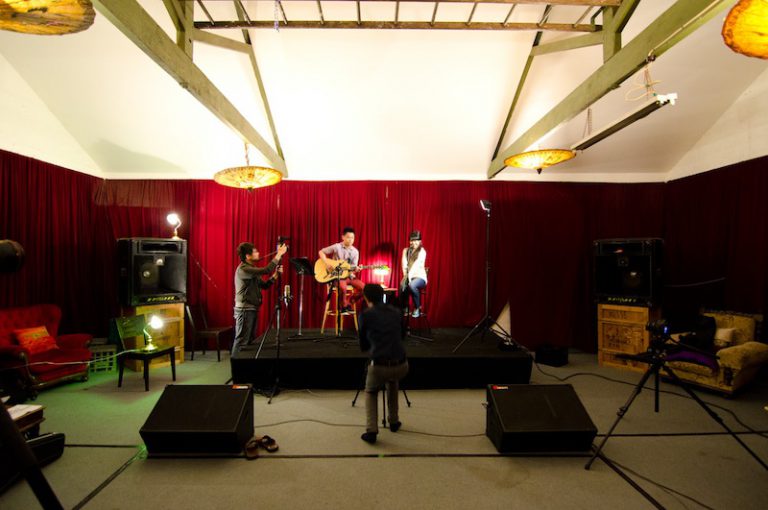Even someone who has never been inside a music studio might have a pretty clear idea about such a place: it is usually a pretty bland environment, unremarkable, save for the mandatory band promo posters, covered in sound-proof material, possibly dusty. The idea is that a music studio is all about functionality, not beauty, the focus point being the acoustics and not the aesthetics.
The people at Bakehouse Studios don’t agree. They should know, as the Richmond establishment has been a creative hub for musicians for almost 25 years, offering a haven for more than 400 artists – from Nick Cave, Olivia Newton-John, the Cat Empire, the Drones and the Dirty Three to Wanda Jackson, Cat Power, Beck and Elvis Costello, who famously described the place as “some of the best rooms in the world”.

Since last year, these rooms have transformed to something more than rehearsal and recording studios: they are Melbourne’s most exquisite, inspired and exclusive art gallery, as each room has been transformed into an art installation, by an array of creative artists, among them Emily Floyd, Patricia Piccinini, Cass Partington and guitarist Mick Turner.
The difference between Bakehouse and any other studio in the world is similar to the one that distinguishes birthing rooms to delivery suites in hospitals. Babies are born in both, but a delivery suite is a sterile, clinical environment while birthing rooms create the perfect conditions for a new life to enter the world. In a similar way, Bakehouse studios are birthing rooms for music, creating the perfect setting for musicians to relax, concentrate, be inspired and create. Furthermore, the studios feature a communal kitchen and a spectacular courtyard, a meeting point for the artists occupying the rooms at any given time, something that enhances interaction and communication.

THE DYNAMICS BETWEEN SOUND AND VISUAL ART
“We have been in hospitality for a long time and we understand what they [the artists] need,” says Helen Marcou, who owns the studios with her husband Quincy McLean, himself a musician. Asked about the dynamics between the visual and the musical, the way that each room’s decoration can affect the creative process, she says that she has noticed that “different bands gravitate to different spots”, not only because each room has different acoustics, but also on account of the general atmosphere created. In the end, each room’s atmosphere becomes “part of the sound”.
She describes the charm of the room that Mick Turner created, with its large sound-proof window overlooking the (eerily muted) traffic; she jokes about a certain “heavy” band that chose to rehearse in the softly pastel coloured ‘Ladies Room’ (created by the Hotham Street Ladies, and featuring a mural made from piped icing, capturing the view from the French hotel in which the Rolling Stones recorded ‘Exile on Main Street’); and she marvels at the ‘Book Room’ (by Stewart Russell and Nicholas Jones) and the way “the words leap off the pages”.

As for which of the rooms is her favourite, she says that it is like asking her to “pick her favourite child”.
Helen Marcou, of course is herself a kind of mother figure for Melbourne’s vibrant music scene; she was the driving force behind the highly successful ‘Save Live Australian Music’ (SLAM) campaign, which promoted the interests of live music venues, lobbying for the change of legislature. Most recently, she was featured in Neos Kosmos, as an integral part of the LISTEN collective, an attempt to battle sexism in Australian music, through education, advocacy and activism.
Now she has added another feather to her cap, as she, along with her partner and publisher Sophy Williams, recorded the transformation of the Bakehouse Studios to an ongoing art installation, in a fascinating art book entitled The Bakehouse Project. The night of the launch, she was greeting everyone, loudly singing their name, as they came to celebrate her labour of love.

A PUBLIC ART GALLERY
Although the idea was floating for some time, the spark was Lou Reed’s demise. Shortly after the legendary rocker’s death, a Melbourne-based street advertising company pasted two posters of Reed on the external front wall of Bakehouse Studios, on Punt Road, Melbourne’s busiest artery.
“We were so moved by his death, that we decided to activate the space,” says Helen, mentioning the overwhelming emotional response she received by the people who saw the giant photographs. The exterior has been doubling as a kind of public art gallery, presenting a rotation of large-sized display of art to the thousands of people driving by each day.
Given that the walls are coveted by advertising companies as prime spots for placement, Helen Marcou and Quincy McLean’s choice to turn their backs on an offer that few people would object to says a lot about them.

“We may not have the material riches,” she says, “but we do have a rich cultural life. That’s what happens with the choices you make. We chose art over wealth. This means that we may never have the opportunity to retire to a Greek island,” she adds, laughing.
For some, it might be frustrating that this unprecedented art project is restricted to musicians, as the rooms are accessible only to the bands who book them to rehearse. However, Helen Marcou gives regular tours on Saturday mornings for groups of six or more people. The tours come with a book purchase per couple. Be warned, though – you might feel the urge to unearth your guitar and re-form your high school band afterwards.